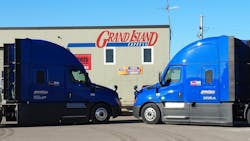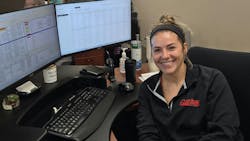Data-driven decisions enhance reefer revenue
Strategic freight planning is affected by a countless number of variables—far too much for a single person to follow precisely. When bumping against the limits of what human decision-making can anticipate, data-driven technology can help.
Grand Island Express, a refrigerated carrier that is consistently recognized as one of the Best Fleets to Drive For, had reached that limit of human-driven freight planning.
“We were dispatching in a reactionary type of format,” Deen Albert, VP of operations for Grand Island Express, told Refrigerated Transporter.
Thanks in part to an intelligence freight planning platform, the carrier is now proactive in its dispatching. The Optimal Dynamics platform helped the company forecast its operations and logistical conditions with greater accuracy and precision.
Grand Island is now consistently breaking its previous revenue and loaded mile records while reducing stress on its internal teams. The technology helped Grand Island to not only enhance its revenue but to remain one of the Best Fleets to Drive For.
Limits to human decision-making
Grand Island Express is a Nebraska-based refrigerated carrier that hauls to 38 states, primarily moving beef. The company was founded in 1967 and now commands about 169 tractors and more than 300 trailers.
In the years following Refrigerated Transporter’s profile on Grand Island Express in 2021, the company continued to improve its operations. Over the next years, Grand Island Express focused on increasing its network velocity. The carrier increased its average load count by decreasing the average length of haul.
“We eliminated a lot of delay time,” Albert said.
After partnering with Optimal Dynamics, the carrier began improving network efficiency and reducing empty miles. Most of Grand Island’s headhauls run along the company’s primary lanes to the northeast. The deliveries are precisely timed, and in order to find backhauls, Grand Island will pick nearby available loads—from other refrigerated goods to non-refrigerated dry van freight.
“During the past two years, we squeezed everything we could out of our network, but there are limits to what humans can bring into their decision-making process,” Albert said in August. “This need to automate and optimize operations made us look into Optimal Dynamics.”
What does the platform do?
Optimal Dynamics is a technology company providing an eponymous transportation planning platform. The platform aims to improve decision making, from strategic planning to RFPs and execution, by utilizing large amounts of data with the company’s decision intelligence engine.
One of the platform’s main functions is to increase revenue per truck per week. It primarily does so by suggesting ways to match trucks to freight. Customer fleets can follow those suggestions to optimize their operations. Customers can also look at hypothetical operational statistics in a digital twin sandbox to identify optimal decisions under a variety of circumstances.
It can be overwhelming for a dispatcher to juggle driver home time, historical load patterns across several sectors, headhaul and backhaul timings, load profitability, asset utilization, and so much more. The platform can provide a more information-inclusive perspective than what humans are generally capable of, Albert said.
Optimal Dynamics receives its data through the fleet’s transportation management system. If a customer has an unsupported TMS, “we’ll work directly with that TMS provider,” Erica Frank, VP of marketing for Optimal Dynamics, told Refrigerated Transporter.
After TMS integration, training, and database housekeeping, Frank said that Optimal Dynamics can get customers set up in a matter of weeks.
Beginning a partnership
Grand Island began working with Optimal Dynamics in January and went live with the platform in April.
The ramp-up before going live required a few things in place for the platform to work correctly. Optimal Dynamics needed a rich supply of data to drive its operation, and Grand Island needed to restructure its personnel to fit platform-driven operations.
Grand Island uses the McLeod Loadmaster TMS, which supports two-way integration with the Optimal Dynamics platform, allowing for easy information access. However, the carrier still needed to enrich logs for things like driver home time or tractor maintenance.
Grand Island began using Optimal Dynamics to automate some of its load allocation and dispatching decisions. The carrier’s business analytics manager also uses the platform’s bidding feature to back up their own decisions.
In its first week using the platform, Grand Island Express booked about 50% of its loads to the platform’s recommendations. By the second week, that adoption rate reached 84% and has remained high since.
Operational benefits
Since implementing the platform and adopting its recommendations, Grand Island has significantly improved its weekly revenue per truck.
Year-over-year comparisons for May, Grand Island’s first full month of the platform, showed strong improvements: a 5.7% increase in linehaul revenue, 9.3% increase in load count, and 13.6% increase in loaded miles.
The carrier was moving “more volume than we ever had with functionally less people,” Albert said.
Previously, when Grand Island reached revenue records, its operations would slow down as it reeled from exhausting its capacity, Albert noted. With the Optimal Dynamics platform, Grand Island has been able to consistently stack records—topping three revenue records and two loaded mile records since April.
Some of those revenue records could be attributable to Grand Island’s moderate fleet growth; however, per-truck revenue also rose. Overall revenue per truck per week increased 13.4% over its previous baseline average.
Staying a Best Fleet to Drive For
Grand Island Express takes driver satisfaction seriously. The carrier has received 13 consecutive awards under the Best Fleets to Drive For program.
With the platform, Grand Island’s driver managers have more time to focus on the drivers, which Albert said makes the company a better fleet to drive for.
When a driver manager is spending most of their time putting out fires and 10% of their time focusing on drivers, they won’t be able to serve drivers adequately. Now, managers can spend 90% of their time focusing on drivers.
“We’ve flipped that narrative,” Albert emphasized.
About the Author
Jeremy Wolfe
Editor
Editor Jeremy Wolfe joined the FleetOwner team in February 2024. He graduated from the University of Wisconsin-Stevens Point with majors in English and Philosophy. He previously served as Editor for Endeavor Business Media's Water Group publications.




